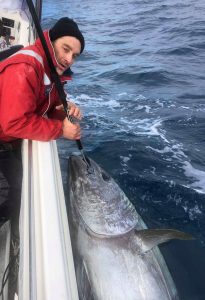
Catch and release: Steve Arthey holding the big tuna alongside before its release (Picture: Nathan Forrester).
Portland
Southern bluefin tuna remain present off Portland, but those being caught are invariably juveniles of 12 kg or so, responding to lures of the appropriate size.
However last week, Geelong anglers Steve Arthey, Nathan Forrester and Jack Jarvis – doyens of several great fish captures – were having none of that, and selectively trolled 12” skirts in the hope of hooking, and then releasing, a large tuna. The day was quiet though, the only sign of activity being the sight of birds circling on the horizon.
Bringing in their tackle and heading over that way, their confidence grew at the surface chaos they beheld; confidence reassured by an explosive strike heralding a tough battle for Nathan that lasted barely 20 minutes in a do-or-die struggle that bought the fish – clearly over 100kg – alongside before its release.
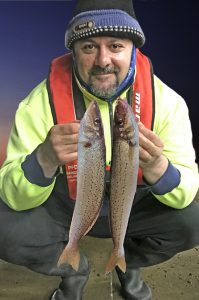
Mark Sesar with a sample of his and Andrew Phillips catch off Indented Head.
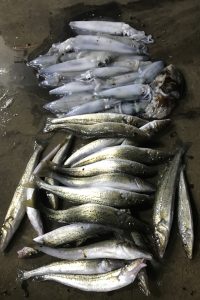
Andrew Phillip’s and Mark Sesar’s catch of whiting and squid from Indented Head on Sunday afternoon and evening.
Corio Bay
Taking advantage of good weather on Sunday, Mark Stewart and his five year old son Rylan, headed out off Clifton Springs where they fished on the drift for squid. However, it was anything but an instructional class with the lad hooking up time after time.
If the truth be known, Mark was in fact a deckhand for young Rylan who finished with 7 squid while Mark managed the grand tally of two.
Speaking of squid, they must be about because Andrew Phillips and Mark Sesar took a bag limit catch off indented Head by around 4.00 pm on Sunday despite the challenge of fishing wind against tide. After that, they tried one of their favoured spots for whiting.
They caught enough to keep them interested until slack water shut that bite down, but they stayed until the ebb tide picked up on dusk. Then they were in business once more, and on a better class of fish. They finished with thirty, the biggest measuring 43 cm.
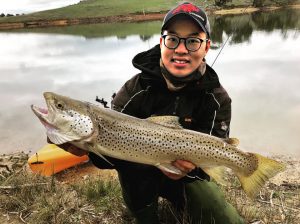
Don Ung with his prize catch from Lauriston Reservoir up past Woodend.
Freshwater
With Lauriston Reservoir – along the Calder Highway north of Woodend – just opened to Kayaks, and with good weather on Sunday, Don Ung was topside soaking a lure.
He was surprised to find he was the only Kayaker out there, and was rewarded for his effort with a trophy size brown trout that looked about 3 kg in the photo.
As part of the State Government’s commitment to have one million participating anglers by 2022, there are plans provide eventual access for craft using electric motors on this water as is now the case at Tullaroop Reservoir.
Kevin Wild of the Maryborough Angling Club reports that the water level in Cairn Curran Reservoir has risen following a recent flush down the Loddon, and hopeful of picking up a yellowbelly or redfin, tried his luck on Sunday using worms for bait.
Although there was plenty of action from carp in the discoloured water, the more desired species failed to show.
John Clements of the Lake Purrumbete Holiday Park reports that chinook salmon to 2 kg are the main chance at present with pilchard fillets suspended just above the bottom a preferred approach.
Among those to catch these were Mick Giles of Bannockburn, Les Broughton from Geelong, Mick Cummings from Altona and too many others to list.
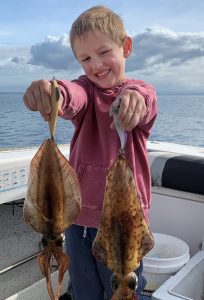
Rylan Stewart 5, with a sample of the squid he caught off Clifton Springs on Sunday (Picture Mark Stewart).
Steven asks:
On July 23 you explained how the moon affects tides, but I come from South Australia where we experience “dodge tides,” so how do they occur?
Steven, since the oceanic tidal bulges caused by the gravitational pull of the moon, modified by that of the sun, travel from east to west like waves in respect to the daily rotation of the Earth, tides on continental east coasts behave predictably, rising and falling twice every 24 hours and progressing on average, some fifty minutes a day.
However, tides on the southern, northern, and on the west coasts of continents, islands and promontories in particular, behave differently because they lie variously in the bow-wave and wake of each tidal bulge, and as such are subject to turbulence and aberrations comparable in some respects, to those displayed in the bow waves and wakes of ships.
These aberrational variants include dodge tides; diminished tidal sequences usually producing only one low and one high tide over a 24 hour period. Dodge tides may occur over several days and are associated with the first and last quarters of the moon.
